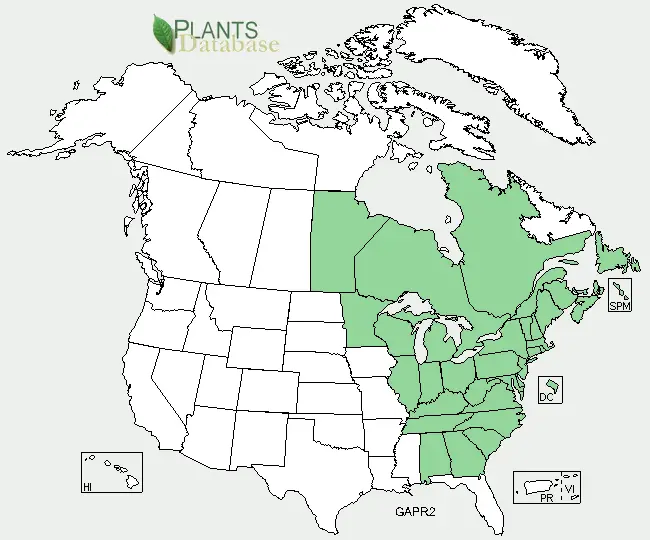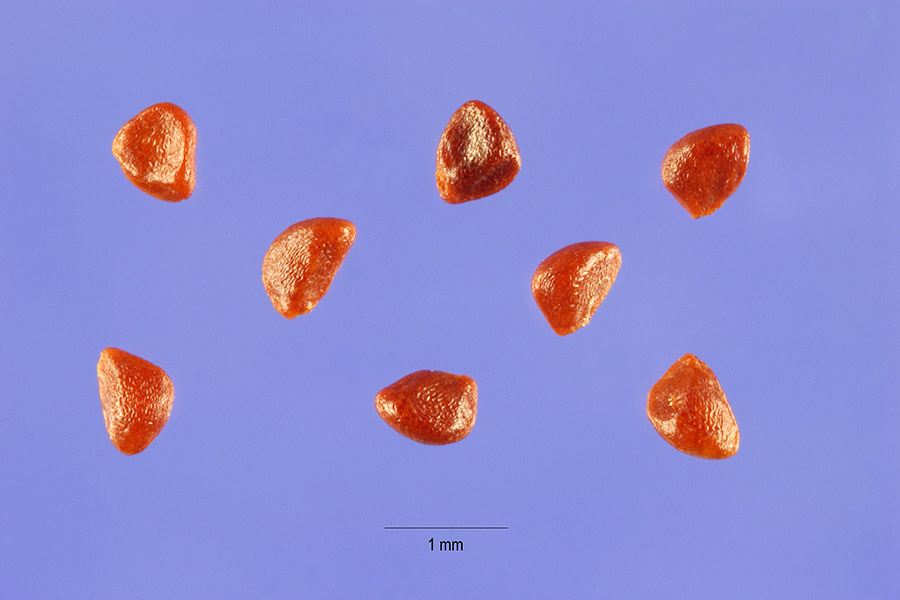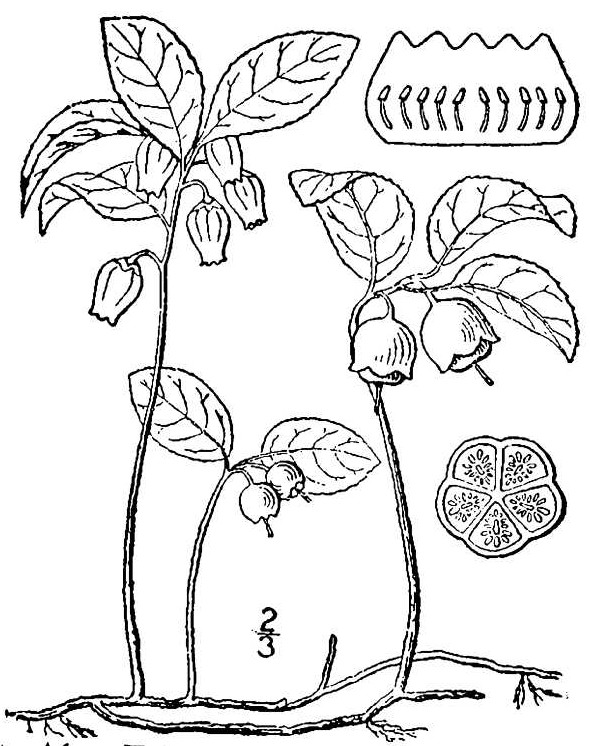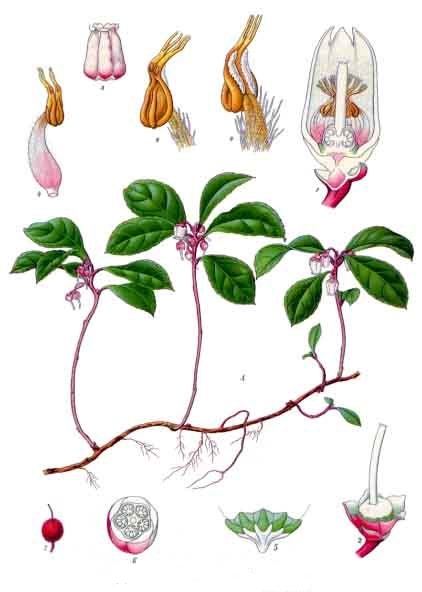
Search Wild Foods Home Garden & Nature's Restaurant Websites:
Wintergreen
Wintergreen with berries. (Dryas CC BY-SA 3.0)
(NOTE: If you are not interested in growing Wintergreen, but just finding the plant and using it, try going to the Nature's Restaurant Online site Wintergreen page.)
Wintergreen (Gaultheria procumbens). This plant has a remarkable number of common names which include: Eastern Teaberry, Checkerberry, Creeping Wintergreen, Boxberry, American Wintergreen, American Mountain Tea, Boxberry, Canada Tea, Canterberry, Chickenberry, Chinks, Deerberry, Drunkards, Gingerberry, Ground Berry, Ground Tea, Grouseberry, Hillberry, Mountain Tea, One-berry, Partridge Berry, Procalm, Red Pollom, Spice Berry, Squaw Vine, Star Berry, Spiceberry, Spicy Wintergreen, Spring Wintergreen, Teaberry, Wax Cluster, Youngsters. It even has extra Latin names: Brossaea procumbens & Gaultheria humilis. Certainly not an ignored plant by those who bestow names.
Is the growing of this plant compatible with Natural farming, Ecoagriculture or Eco friendly agriculture, Ecological farming, Sustainable agriculture, Agroforestry or Agro-sylviculture and Permaculture: This plant works well in a shaded Natural farming or no-till garden. The soil around this plant never needs tilling once it is planted.
This low shrub is commonly found in low nutrient acidic soils in conifer woods. The name Wintergreen comes from the fact that the plant is not Deciduous, but is an Evergreen - keeps its leaves all season long, hence it is green in the winter, or Winter-green. The reason it does this is a response to growing in low nutrient soils - it would take a lot of nutrients and energy to regrow new leaves each spring.
I included this one for those who live where you have a lightly shaded area and acidic soils that are poor in quality. In these conditions, this is a great ground cover choice, plus you get the added bonus of having the berries. This is a slow growing plant - it grows where the soil is poor, but given the time, can spread and colonize a wide area. Occasionally, I have seen it for sale at nurseries.
Soil & Site: Grow this in a lightly shaded area. I would suggest digging in peat moss and conifer needles or sawdust with the soil before transplanting. You will need to make sure the soil stays damp most of the time for the first year. It can grow in soils that range from very acidic to almost neutral.
Transplanting: The best way to start this one is by transplanting a section of it. Early spring after the ground has thawed or late in the year before the ground has frozen, though I think if you were careful, you could move this any time of the year as long as you took a large, deep section and kept it moist after the move.
Seeds: You can also start this one by seed if you find some berries, or purchase the seeds. If you do go the seed route, be aware the seeds need to be stratified by mixing in with some slightly damp peat moss, put in a sealed baggie and put in a fridge for a few months. The peat moss needs to stay lightly moist. After a couple of months check on them to see if they are sprouting. When they sprout, plant shallowly in some very damp, but not soaking wet peat moss, sand and soil or loose acidic potting soil. Put where it can get good light, but not direct sunlight. Plant in the garden when the plant has leaves and after the last frost of the spring.
Maintenance: If you have put them in the right conditions, there is nothing to do. They should not be fertilized. Just put some conifer needle mulch in and around them lightly each year (don't bury them) if they are not growing under conifer trees.
Harvesting: The berries are ready to be harvested starting in late fall and well into the winter. So you don't damage the plant, or pull it up by the roots, use scissors to cut off the berries.
Using: The berries can be cooked and used in recipes, or a couple eaten raw while outside. The leaves, though they should never be consumed raw, can be used for making tea. See the recipes links under the description for ideas.
Caution: This plant, especially the leaves contain Oil of Wintergreen which is a high concentration of a natural Aspirin (an ester of salicylic acid). One ounce of Oil of Wintergreen contains the equivalent of about 170 adult Aspirin tablets. If you are allergic to Aspirin, don't consume any part of this plant. Also, consider eating the raw leaves poisonous. They are often made into a medicinal tea, but the toxic components are released when heated. Also, because of Reye's syndrome, children under 12 and teenagers should probably not eat these.
Description:
- USDA Plant Hardiness Zone: 3-7 (More information on hardiness zones).
- Soil pH: 3.5-6.9
- Plant Size: Generally 10–15 centimeters (4 to 6 inches) tall
- Duration: Perennial creeping Shrub
- Leaf Shape: Ovate to Elliptic
- Leaf Phyllotaxis (Arrangement) on branch: Alternate
- Leaf Size: 2–5 cm (4/5 to 2 inches) long and 1–2 cm (2/5 to 4/5 inches) wide
- Leaf Margin: Entire to Serrate
- Leaf Notes: Leaves are Evergreen. Leaves have distinctive Wintergreen oil scent. Leaf surface is glossy. Leaves turn red to purple in fall.
- Flowers: Singly or raceme of 5 mm long bell or urn shaped 5 petalled white flowers
- Fruit: Bright "Christmas" red, 6–9 mm (1/4 to 1/3 inch) diameter. Mint like flavor. Berries are ripe in September and stay on the plant until spring.
- Habitat: Tends to be found in conifer woods in acidic soils low in nutrients. If there is a lot of shade, don't expect berries, even if the plant is doing fine. Look for the berries in plants in the woods where a good amount of light reaches the forest floor.
Web Resources:
- Recipe search on the web for using the berries here (Google search) and here (Bing search).
- Recipe search on the web for making tea here (Google search) and here (Bing search).
- Pictures on the web here (Google images) and here (Bing images).
- Interactive USDA distribution map and plant profile here.
- The Biota of North America Program (BONAP) distribution map here. BONAP map color key here.

Wintergreen (Gaultheria procumbens) range. Distribution map courtesy of U. S. Department of Agriculture (USDA Natural Resources Service) and used in accordance with their policies.
Wintergreen in flower. (Jomegat CC BY-SA 3.0)

Seeds (Steve Hurst, hosted by the USDA-NRCS PLANTS Database)

Drawing. (USDA-NRCS PLANTS Database / Britton, N.L., and A. Brown. 1913. An illustrated flora of the northern United States, Canada and the British Possessions. 3 vols. Charles Scribner's Sons, New York. Vol. 2: 693)

Color drawing. (Franz Eugen Köhler, Köhler's Medizinal-Pflanzen)
Search Wild Foods Home Garden & Nature's Restaurant Websites:
Share:
Why does this site have ads?
Originally the content in this site was a book that was sold through Amazon worldwide. However, I wanted the information to available to everyone free of charge, so I made this website. The ads on the site help cover the cost of maintaining the site and keeping it available.
Google + profile
